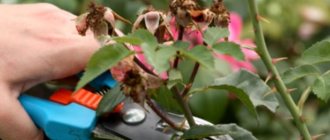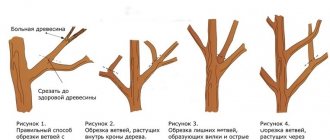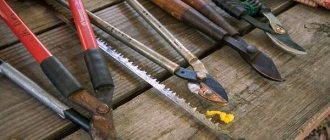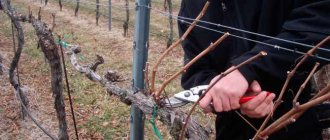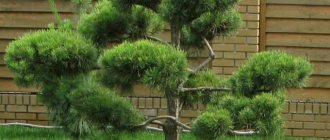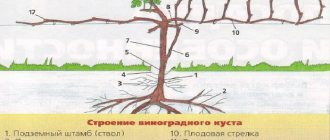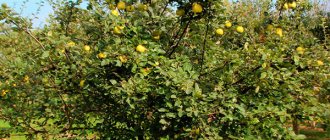Do roses require pruning?
Pruning roses in the fall is necessary for several reasons. Pruning provides:
- rapid flowering of roses next year;
- complete wintering of the bush without numerous shoots that will weaken the bush during wintering;
- giving the bush a compact appearance for more convenient shelter for the winter;
- making it easier for the roots to provide nutrients to the shoots;
- removal of weak and diseased branches with faded buds and pests that have settled on them;
- plant rejuvenation;
- the bush subsequently acquires a beautiful appearance.
If you do not prune roses, the crown may die off with age; root growth that is not removed in time will fill the middle and make the bush look sloppy.
What is different about autumn rose care?
Spring and summer care for roses is aimed at active growth and development of plants. Autumn care, on the contrary, involves slowing down their vegetation. Why is this necessary? Roses change their state somewhat in autumn:
- Lignification of the stems occurs;
- Shoots and buds slow down development;
- The root accumulates nutrition and strengthens;
- All metabolic processes slow down.
This is how nature prepares rose bushes for frost. How to properly care for roses in the autumn? Let's figure it out.
Basic rules for pruning
During wintering, it is customary to leave no more than 7 shoots on the bush. The procedure for removing and shortening the stems begins when a stable outside temperature reaches about -2 degrees. In the middle zone this is the end of October - beginning of November.
Trimming tools
The main tool for thinning bushes is a garden pruner, but experienced gardeners also use a sharp knife. To cut thick branches that are more than 2.5 cm in diameter, you may need a hacksaw.
Preparation for pruning
By the end of September:
- Stop watering and loosening the soil under the roses to slow down the growth of shoots.
- Late buds are prevented from blooming by pinching them.
- If there are heavy rains, a canopy is pulled over the rose garden.
- Hill up the bushes to a height of 10-20 cm.
Pruning technique
How to prune a shoot correctly? To begin the procedure, in addition to the pruning shears, you need to prepare: garden varnish, thick gloves to protect your hands from thorns, a pink solution of potassium permanganate to disinfect the tool. Basic Rules:
- the cut is made 1-1.5 cm above the bud at an angle of 45 degrees;
- the cut is made in one movement, without burrs;
- do not make a cut above the bud looking inside the bush.
Attention! The stems, which in the future will grow from a bud looking outward of the bush, will create a beautiful cup-shaped shape in which the shoots will not interfere with each other.
The cut wound must be immediately covered with garden varnish to avoid infection and rotting of the bush. After pruning, not only excess branches are removed, but also fallen leaves and other debris near the rose bushes, which pests can use for wintering. After the pruning procedure, not only the plants, but also the ground underneath them are treated with fungicides.
Preparing for shelter
Safely hiding roses from frost is the main goal of preparing for winter. This should be taken seriously as the survival of plants depends on the process.
Roses need feeding before winter. For this purpose, a complex fertilizer is suitable, which will saturate the roots of the plants and support the entire cold period. It should include:
- phosphorus;
- calcium;
- monopotassium phosphate;
- superphosphate;
- potassium sulfate;
- boric acid.
You can add ash.
Then all the leaves under the plant are cleaned and burned to kill the pests located there. To prevent fungal infections, plants are treated with copper or iron sulfate. And with the first frosts you should start insulating.
When to start loosening the soil?
Already at the beginning of autumn you can start preparing roses for winter. In mid-September, the leaves on the lower part of the bush are removed and the plant is earthed up. Loosening the soil is carried out to a height of 30 centimeters.
For hilling, take nutritious dry soil mixed with sand. You cannot rake the soil next to the bush, so as not to accidentally expose the roots. You cannot add peat mixture to the soil, otherwise on frosty days it will turn into sharp large stones that can damage the bark of the plant.
Insulating the roots by loosening will prevent damage and cracks that occur under the influence of severe frost.
How and how to cover roses for the winter?
High-quality material is selected to cover roses. It must meet the requirements that allow the plant to create an ideal microclimate. To protect against evaporation when the frosts begin to subside and prolonged thaws begin, the coating should not be in close contact with the bush. In addition, it must be:
- dense;
- lasting;
- vapor permeable.
These qualities will allow oxygen to flow freely and the plant will not suffocate.
Important: it is better to hide a rose for the winter later than prematurely.
You can cover the plant using different schemes and methods:
- air, when a house is made from a frame, stretched with polyethylene, and covered with soil;
- shield, when the branches are tied in a bunch, bent to the ground, and polyethylene or agrofibre is stretched on top;
- Place jute bags on top of the plant;
- wrap it in cardboard.
Standard roses that grow in tubs are taken to a cold basement.
Pruning times in different regions
In different regions, pruning occurs at different times. Autumn in the Leningrad region is famous for rain and winds. To shorten branches and remove excess shoots, choose a dry, clear day in mid-October. To obtain even and smooth cuts on bushes, you need a high-quality tool. The wounds are immediately treated with garden varnish or sprinkled with ash. After a few weeks, the plants are covered with sawdust, peat, and covering material.
In Siberia and the Urals, winters come quickly and are characterized by strong drops in temperature. Therefore, in these parts, roses grafted onto rose hips will better withstand extreme conditions. The shoots are not shortened too much at the end of September and the rose bushes are covered after 2 weeks.
Trimming methods
In the fall, gentle pruning is done to injure the plant as little as possible. For novice gardeners, various methods of shortening shoots are of interest.
Traditional pruning
This method is suitable for shortening all types of roses. Remove:
- young root shoots;
- immature shoots;
- weak branches;
- dried stems;
- branches with visible signs of disease.
After thinning, the plant has 5-7 healthy shoots that need to be slightly shortened.
Heavy pruning
This means cutting the bush almost to the base, after which only a few stumps with 2.3 buds remain. In the spring, powerful shoots are formed, blooming 1-1.5 months later than with light pruning.
Moderate pruning
When using this method, the stems are shortened by half. There are 4-5 buds left on the stem. In the summer of next year it forms long stems suitable for cutting; the bushes bloom a little later than with slight shortening.
You may be interested in:
Timing for covering roses for the winter in the Moscow region It is only beginner gardeners who think that with the onset of autumn and after harvesting, work on the site is completed.... Read more...
Easy trimming
In this case, the stems of the rose bush are cut by 1/3 and up to 10 buds are left. The method is not suitable for rose varieties capable of rapid growth. In June of next year, the bush pleases with abundant flowering, but the short branches that have grown do not provide the opportunity to create a bouquet.
Attention!
This method is not suitable for annual pruning due to the rapid aging of the bush.
Caring for roses in September
At this stage, you must adhere to the following rules:
- We stop trimming roses for bouquets, as this stimulates the growth of new buds. For young roses that you did not allow to bloom in the summer, you need to leave the last inflorescences and let them ripen;
- Reduce watering. If September is hot and dry, you can water your roses once a week until the middle of the month. After watering, we do it once every 2 weeks and completely stop watering the rose garden by the end of September;
- We replace growth-stimulating nitrogen fertilizers with potassium-phosphorus fertilizers. This way we will strengthen the root, and the plant will better survive the cold. We often don’t feed roses; two feedings are enough.
Your actions this month:
I. Feeding the roots with a potassium phosphate composition
You can scatter dry granules near the roots and lightly compact them into the soil, or you can prepare a liquid solution (see tips above) for watering or spraying the green part of the roses.
II. Last loosening of the soil
It is better to do it immediately after feeding the bushes. This may allow the last rosebuds to ripen faster.
III. Limited watering
Ideally, roses should be watered twice in September - at the beginning and towards the end of the month. If September is not dry, then there is no need to water the rose garden additionally.
IV. Weeding
All young weeds should be removed from the rose garden. They can become a source of infections.
V. Removing the lower foliage of roses
Leaves are also often affected by infections; moreover, their presence can stimulate photosynthesis and prevent the rose from slowing down metabolic processes. All leaves up to a height of 20-30 cm must be removed.
VI. Stem processing
After removing the foliage, bare stems should be painted with garden varnish, water-based solution or other disinfectants. This will protect the bushes from rot and pests that are looking for a place for the winter in the stems of plants.
Methods for pruning different varieties of roses
Abundant flowering of roses is ensured by different pruning methods, which vary depending on the plant variety.
How to prune a climbing rose for the winter
Many gardeners have a question: is it necessary to prune the shoots of climbing roses before covering them for the winter?
Climbing roses can be divided into 2 groups: once-blooming and repeat-blooming. For each group, the methods of shortening the stems are different. For climbing plants, 3-4 replacement shoots are left in the fall, and faded and dry stems are cut off. For large-flowered plants, the stems are shortened by 1/3. Next, the sections are treated with pitch or ash.
Before removing the roses from the support, the ground is covered with spruce branches or a wooden shield is placed on it, the roses are placed on the substrate and covered with spruce branches, roofing material, and covered with earth or sand.
Attention!
In cases with climbing varieties, light pruning is not used due to the threat of death of the bush.
How to prune a floribunda rose
Rose floribunda varieties were obtained as a result of repeated crossings of different varieties of roses. They are bushes of various sizes from large to compact. They bloom with simple, semi-double, double flowers. For inexperienced gardeners, floribundas are recommended for creating hedges that will delight with flowering for a long time.
Floribunda roses need pruning for rejuvenation. Strong and moderate shortening of the plant is based on the ability of this group to quickly recover and the ability to throw out shoots with peduncles from the base of the bush. But such a drastic pruning is more suitable for spring work, and in the fall all diseased, dry, immature stems are removed, leaving a few of the strongest ones and pruned at a height of about 50 cm. Light shortening of the branches is not suitable for these varieties.
How to prune ground cover varieties
They are popularly called carpet roses for their ability to form a flower carpet. Widely used in creating landscape design elements. They can be grown without pruning, but pruning groundcover roses in the fall increases flowering the following season and gives the bush a more decorative shape. Instructions explaining step by step all actions:
- the cut is made at an angle of 45 degrees, 0.5-1 cm above the bud;
- the bud should be on the outside, the cut goes from it, not towards it;
- immature, dried out and diseased branches are cut out with sharp pruners;
- strong stems are shortened by 15-20 cm.
Wounds are treated with a disinfectant.
How to prune park bush roses
Park bush roses are a decoration for any park or garden. They grow up to 1.5 m in height and have a long flowering period of a month. In autumn, leaves are removed from the bushes and under them. For small forms of bush roses, pruning is done by 10 cm, removing inflorescences; for tall bushes, pruning is done by 30 cm.
Attention!
If a park rose has released a bud, it must not be cut off, but broken without tearing it off. In this case, both the formation of buds and the growth of new shoots will stop.
How to prune hybrid teas
Such varieties appeared as a result of selection in the mid-19th century. They are valued by gardeners for their variety of colors, flower sizes and resistance to temperature changes. These varieties are suitable for cutting, as they produce flowers on 1 stem. Pruning hybrid tea roses for the winter is done in order to facilitate shelter for the cold period. The shortening of the shoots is moderate or gentle, since the main cutting will be done in the spring when frozen and damaged stems are removed.
How to prune polyanthus roses
These species appeared as a result of selective selection. Their parents: Chinese tea rose and Japanese dwarf. Polyantha roses are low shrubs about 50-70 cm in height. Used as a border decoration for flower beds and to create group flower arrangements. The branches of polyanthus roses are pruned as follows:
- remove diseased and young shoots;
- for varieties with small flowers, leave 2-3 buds on strong stems and 1-2 on weak ones for the winter;
- For flowers with large flowers, the mature shoots of the current year are removed by 1/3; for older shoots, light pruning is done.
How to trim miniature roses
These groups of roses require the least pruning. Before leaving for the winter, diseased, immature branches, flowers and dried inflorescences are removed from the bushes.
How to prune standard roses
Standard roses are obtained as a result of grafting onto rose hips. Hybrid tea, floribunda, climbing and groundcover are used as grafting material. In the first year of planting, in the fall, flowering branches of the tree are pruned, removing green young shoots. In subsequent years, the haircut is done according to the pruning of the grafting variety.
How to prune roses in autumn: general principles
All plants are subject to pruning, regardless of age. First of all, dry, damaged and diseased shoots are cut out, that is, sanitary pruning is carried out. Then the bush is inspected and excess shoots are removed: 3 to 5 well-developed stems are left, if possible located one at an equal distance from each other.
There is no need to leave immature shoots with thin and tender bark for the winter.
Removing immature shoots
They can rot under the covering material, infecting the entire bush.
During pruning, the cutting planes of the pruning shears are positioned at an angle relative to the shoot, trying to make an oblique cut.
Along this cut, moisture flows freely without penetrating into the core of the stem. You also need to make cuts with a hacksaw obliquely. To prevent new branches from growing inside the bush and intersecting during growth, pruning is carried out above the outer bud, stepping back 0.5 cm. Annual shoots are cut with pruning shears, and thicker trunks with lignified bark are cut out with a hacksaw.
Important. To shorten shoots, use a clean, sharp garden tool. A dull pruner will leave ragged marks that will take a long time to heal. It is recommended to disinfect the tool before using it.
When roses are pruned, the leaves are removed from the shortened stems. To do this, a hand dressed in a thick mitten is passed along the branches from bottom to top, tearing off the foliage. All plant debris is collected with a fan rake and removed from the flower garden. These are general principles that apply to all types of roses, but the developmental characteristics of a particular species should also be taken into account.
Care after pruning
2 weeks after pruning, the plants are fed with phosphorus and potassium fertilizers so that the roses can gain strength and endure the harsh winter. The bushes do not require watering; they gradually begin to hibernate.
It is necessary to cover rose bushes when the temperature reaches -5 degrees. Oak leaves, spruce branches, sawdust, and peat can be used as covering materials. You can place arches over small bushes and cover them with lutrasil or spunbond.
Storing cuttings until spring
When forming a bush, it is necessary to remove not only weak and diseased branches, but if the bush is too thick, also healthy stems, from which a varietal plant can subsequently be grown. There are several ways to store cuttings in winter:
- Storage in moss. Cuttings about 12-15 cm in size with 2-3 buds are kept in a root former solution. Sphagnum moss, previously treated with phytosporin, is laid out on a newspaper, cuttings are placed on it, and moss is again on top. Wrap in newspaper or plastic bag and put in a cool place until it gets warm. This could be on the refrigerator shelf or in the basement.
- You can save cuttings until spring by rooting them in potato tubers. The plant will begin to develop quickly, receiving the necessary nutrients from the potato. To do this, select a healthy medium-sized tuber, remove the eyes, and disinfect it with potassium permanganate. The tips of the cuttings must be kept in the same solution for some time. Holes are made in the tubers according to the diameter of the branches and inserted. The tuber itself is planted in a pot with soil, covering the plant with a jar until the cutting is completely rooted.
- Cut cuttings are stored together with a bush covered for the winter.
None of the methods provides 100% safety, but with desire and experience, you can breed different varieties from cuttings.
Rose is a capricious and fastidious plant, which, with proper care and tender care, will reward you with its decorative appearance, fragrant blooms and the beauty of its flowers.
